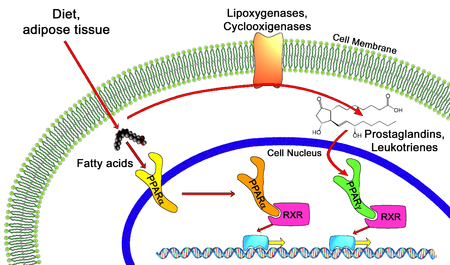Peroxisome proliferator-activated receptor

In the field of
Nomenclature and tissue distribution
Chr. 22 q12-q13.1 | |||||||
|---|---|---|---|---|---|---|---|
| |||||||
Chr. 3 p25 | |||||||
|---|---|---|---|---|---|---|---|
| |||||||
Chr. 6 p21.2 | |||||||
|---|---|---|---|---|---|---|---|
| |||||||
Three types of PPARs have been identified: alpha,
- α (alpha) - expressed in liver, kidney, heart, muscle, adipose tissue, and others[6]
- β/δ (beta/delta) - expressed in many tissues, especially in brain, adipose tissue, and skin
- γ (gamma) - although transcribed by the same gene, this PPAR, by way of alternative splicing, is expressed in three forms:
- γ1 - expressed in virtually all tissues, including
- γ2 - expressed mainly in adipose tissue; it is 30 amino acids longer than γ1
- γ3 - expressed in large intestine, white adipose tissue
History
These agents, pharmacologically related to the fibrates were discovered in the early 1980s.
PPARs were originally identified in Xenopus frogs as receptors that induce the proliferation of peroxisomes in cells in 1992.[7] The first PPAR (PPARα) was discovered in 1990 during the search for a molecular target of a group of agents then referred to as peroxisome proliferators, as they increased peroxisomal numbers in rodent liver tissue, apart from improving insulin sensitivity.[8]
When it turned out that PPARs played a much more versatile role in biology, the agents were in turn termed PPAR ligands. The best-known PPAR ligands are the thiazolidinediones.
After PPARδ (delta) was identified in humans in 1992,[9] it turned out to be closely related to PPARβ (beta), previously described during the same year in an amphibian, Xenopus. The term "PPARδ" is generally used in the US, whereas the use of "PPARβ" has remained in Europe, where this receptor was initially discovered in Xenopus.
PPARs were so-named because they were discovered to induce peroxisome proliferation in rodents, but this induction of peroxisome proliferation is not believed to occur in humans.[10][11]
Physiological function
All PPARs
The function of PPARs is modified by the precise shape of their ligand-binding domain (see below) induced by ligand binding and by a number of
Endogenous ligands for the PPARs include
for a review and critique of the roles of PPAR gamma in cancer.Genetics
The three main forms of PPAR are transcribed from different genes:
- PPARα - chromosome 22q12-13.1 (OMIM 170998)
- PPARβ/δ - chromosome 6p21.2-21.1 (OMIM 600409)
- PPARγ - chromosome 3p25 (OMIM 601487).
Hereditary disorders of all 3 of these PPARs have been described, generally leading to a loss in function and concomitant
Structure
Like other nuclear receptors, PPARs are modular in structure and contain the following
- (A/B) - N-terminal region
- (C) DBD - DNA-binding domain
- (D) - flexible hingeregion
- (E) LBD - ligand binding domain
- (F) C-terminal region
The DBD contains two
The LBD has an extensive
Pharmacology and PPAR modulators
PPARα and PPARγ are the molecular targets of a number of marketed drugs.
For instance the
The
The synthetic chemical perfluorooctanoic acid activates PPARα while perfluorononanoic acid activates both PPARα and PPARγ. [citation needed]
Berberine inactivates PPARγ. [citation needed]
Other natural compounds from different chemical classes activate or inactivate PPARγ.[21][22][23]
See also
References
- S2CID 2240461.
- PMID 24505284.
- PMID 19609453.
- ^ PMID 11818483.
- PMID 16476485.
- PMID 22247890.
- S2CID 3148132.
- S2CID 4306126.
- S2CID 23506853.
- PMID 29197930.
- S2CID 241510571.
- PMID 17306620.
- ^ Biochim. Biophys. Acta 1736:228-236, 2005
- S2CID 232300877.
- ^ Mol. Pharmacol. 77-171-184, 2010
- PMID 19208833.
- ^ Curr. Mol. Med. 7:532-540, 2007
- PMID 15464424.
- PMID 15367918.
- PMID 17317294.
- PMID 23811337.
- PMID 23630612.
- .
External links
- [1] (PPAR Resource Page, Penn State University).
- [2] (Nuclear Receptor Resource).
- PPAR reference outline Archived 2020-02-14 at the Wayback Machine (Rutgers University).
- Peroxisome+Proliferator-Activated+Receptors at the U.S. National Library of Medicine Medical Subject Headings (MeSH)
- Proteopedia Peroxisome_Proliferator-Activated_Receptors - the Peroxisome Proliferator-Activated Receptor Structure in Interactive 3D
